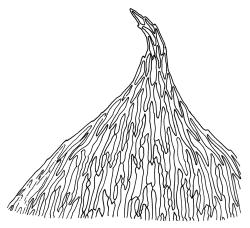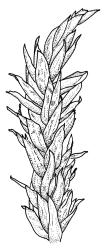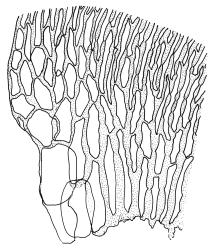- ≡ Hypnum sarmentosum Wahlenb., Fl. Lapp. (Wahlenberg) 380 (1812)
- ≡ Calliergon sarmentosum (Wahlenb.) Kindb., Canad. Rec. Sci. 6: 72 (1894)
- ≡ Acrocladium sarmentosum (Wahlenb.) P.W.Richards & E.C.Wallace, Trans. Brit. Bryol. Soc. 1: XXV (1950)
- ≡ Sarmentypnum sarmentosum (Wahlenb.) Tuom. & T.J.Kop., Ann. Bot. Fenn. 16: 223 (1979)
Plants medium-sized, wine-coloured, less often chestnut- or yellow-brown, rarely nearly black, forming extensive mats or occasionally as scattered stems among other mosses, often submerged. Stems sparsely, irregularly, and radially branched, from c. 40–70(–90) mm, terete and cuspidate at tips, in cross-section lacking a hyaloderm, with a distinct central strand. Leaves loosely erect, oblong-ovate, cucullate, obtuse or short-apiculate (especially near stem tips) and often weakly reflexed at apex, entire, striolate when dry, smooth or very weakly striolate when moist, weakly decurrent, c. 2.0–2.3(–3.5) × 0.5–0.7(–0.8) mm (under cover slip); upper laminal cells linear, (33–)60–75 × 3–5(–6) µm, firm-walled and porose, smooth, shorter and wider in apex, lacking rhizoid initials and abaxial rhizoids; alar cells abruptly differentiated and forming a rather large and weakly decurrent group of thin-walled, inflated, and ± hyaline cells. Costa well-defined, unbranched, extending ¾ to nearly the full length of leaf. Branches cuspidate at tips. Branch leaves not differentiated.
Dioicous? Sex organs and capsules not seen in N.Z. material.
Kanda 1977, fig. 52, 1–8 (as Calliergon sarmentosum); Crum & Anderson 1981, fig. 493 (as C. sarmentosum).
The five varieties (excluding the type) and several forms of W. sarmentosa recognised by Karczmarz (1971, as Calliergon) have found little favour among subsequent workers and no attempt has been made to apply his infra-specific concepts here.
Warnstorfia sarmentosa is a highly distinctive species by virtue of its red to nearly black colouration, irregularly branched shoots with terete and cuspidate apices, and short, reflexed leaf apiculi. Confusion is not likely with W. fluitans. Differences in pigmentation, firmer-walled, narrower and more porose upper laminal cells and the absence of rhizoid-initial cells distinguish it from Straminergon stramineum, with which it often grows. Different pigmentation and reflexed leaf apices are usually sufficient to distinguish it from Calliergon richardsonii, although occasional non-pigmented populations occurring in shaded situations are best recognised using laminal cell characters. Scorpidium cossonii occurs in similar habitats and has similar red to nearly black pigmentation but is unlikely to be confused with W. sarmentosa given its very different leaf stance.
Warnstorfia sarmentosa is sometimes confused with elongate forms of Bryum blandum. The firm-walled, porose, and more elongate nature of the laminal cells and the generally shorter costa provide ready means of distinction from the Bryum. The two species appear to have little overlap in their respective altitudinal ranges in N.Z.
NI: Wellington (Ruahine Range); SI: Nelson, Marlborough (Bull Paddock Creek), Canterbury, Westland (Kelly Range, Hōhonu Range, Lake Christabel), Otago, Southland.
Bipolar. Widespread in the northern hemisphere; Patagonia* and South Georgia*. According to Seppelt (pers. comm., 29 May 2002), this species has been collected in Tasmania. Reported by Karczmarz (1971) from Bolivia, Peru, Kenya, and the South Shetland Is and by Hedenäs (2003) from Venezuela and Colombia.
Usually in seepages, flushes, or margins of alpine pools ("tarns"). Often associated with Schoenus pauciflorus and Oreobolus pectinatus in red tussock grasslands and cushion bogs. Frequent bryophyte associates include Blindia robusta, Breutelia pendula, Campyliadelphus stellatus, Climacium dendroides, Drepanocladus spp., and Straminergon stramineum and Isotachis montana. Apparently acidophilic. From 975–c. 1800 m.
This species seems to have been first collected in N.Z. by D. Petrie in 1896 from the Kelly Range, Westland L.D.
N.Z. populations appear to have markedly less decurrent leaves than northern hemisphere populations, but do not differ in other significant features.










